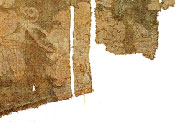 |
 |
|||||||||||||||||
 |
||||||||||||||||||
 |
||||||||||||||||||
| Classified Glossary | ||||||||||||||||||
 |
||||||||||||||||||
 |
||||||||||||||||||
| 9. 1Side The two sides of a woven material are called face, obverse, front side, right side (zhengmian) and the other side reverse or back side (fanmian) respectively. In the process of weaving, if the front side is the faces the weaver, it is called weaving face up (zhengzhi), otherwise, weaving face down (fanzhi). When the spacing of warp and weft threads are approximately the same,the weave is called balanced (junheng). When the warp threads or weft threads dominate the face, it is called warp-faced (jingmain) and weft faced (weimian) respectively. 10. 1Basic weave The three most commonly used structures are called the three basic weaves (sanyuanzuzhi). They are tabby (pingwen), twill (xiewen) and satin (duanwen). 11. 1Tabby Plain and tabby describes the same structure, however CIETA recommends the term tabby. It is represented by 1/1. Through different binding, thickness of threads, thread count, variations from the tabby can be produced. The grouping of warp and weft threads results in extended tabby (bianhuapingwen), including rib weave (chongping) and basket weave (fangping). Varied silk yarns create normal silk tabby (juan), thin silk tabby (sha), heavy silk tabby (ti), spun silk tabby (mianchou) and high twisted yarns create crepe (zhou). All those weaves appeared in the Shang dynasty. |
||||||||||||||||||
| THE BOOK | ||||||||||||||||||
| AUTHOR | ||||||||||||||||||
| CONTENTS | ||||||||||||||||||
| ORDER | ||||||||||||||||||
| CONTACT | ||||||||||||||||||
| LINKS | ||||||||||||||||||